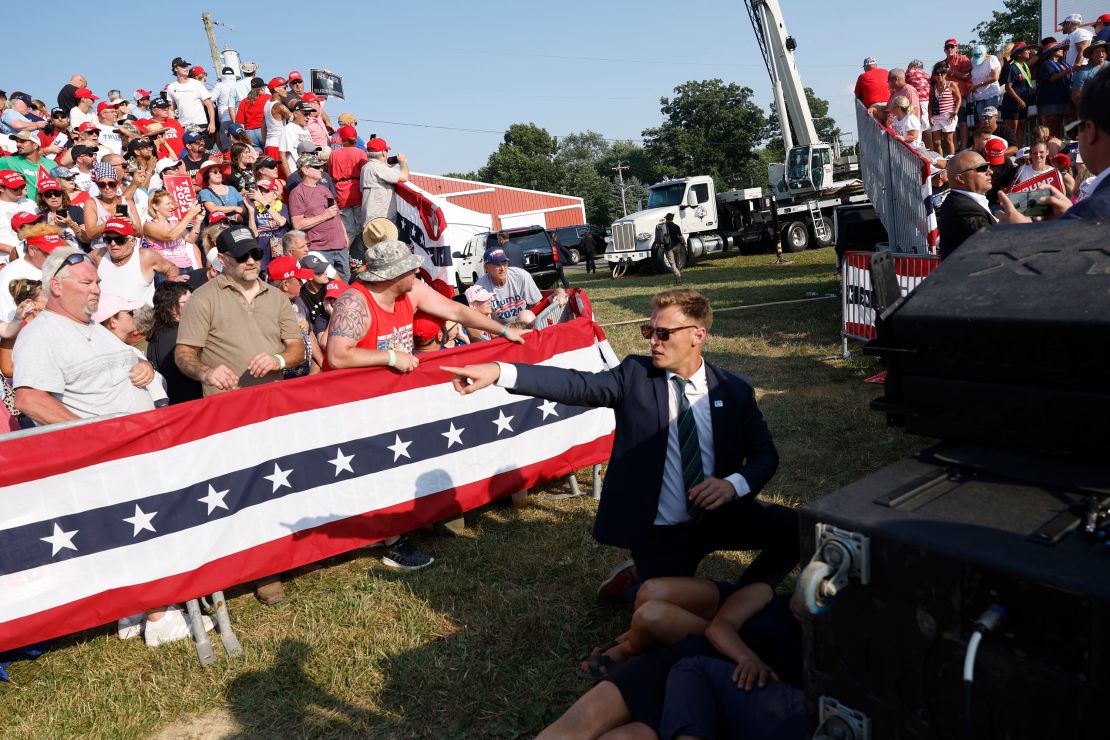CNN
—
A year ago today, I watched as an attempted assassin opened fire on then-candidate Donald Trump.
During the chaos and fear that unfolded — unlike anything I had previously experienced — I questioned not only if he was safe, but also if his ambitions of becoming president yet again would be forever impacted by the events of that day.
The answer to both of those questions was yes.
July 13, 2024, ultimately became the one of the most pivotal moments of Trump’s entire campaign. And the days that followed changed the entirety of the general election and MAGA movement.
Less than 48 hours after the assassination attempt in Butler, Pennsylvania, Trump named then-Sen. JD Vance as his vice presidential running mate. Three days after that, Trump took the stage triumphantly at the Republican National Convention in Milwaukee, wearing a bandage over an ear that had been hit by a bullet. That Sunday, then-President Joe Biden announced he was withdrawing from the race after his disastrous debate performance in June.
Butler made the final stretch of the race far more personal for the president and his team, a White House official who also worked on the Trump 2024 campaign told CNN. The Trump team deliberately chose to ramp up the former president’s schedule after that, ensuring he “never missed a beat” on the trail, the official added. The goal was to show Trump was more committed than ever to winning the race.
“If people were going to try to do this, we were going to go even harder,” the official said. “It became bigger than the election.”
After a bullet grazed Trump’s ear, I watched as he dropped to the ground behind his podium and Secret Service rushed the stage to form a circle around him. After the spray of gunshots finally ceased, and the officers began escorting the former president off the stage, Trump slowly rose up as blood dripped down his face and lifted his fist in the air.
“Fight, fight, fight!” an angry Trump shouted to the crowd. In conversations with multiple Trump campaign officials and advisers in the following weeks, I learned that the president later remarked to his close allies that he knew in that moment he needed to leave his supporters with a potent image.
Trump, who has long fixated on projecting a portrait of strength, did not want the assassination attempt to leave him looking weak, they said.
“He has better political instincts than anyone I know,” a then-Trump campaign adviser told me at the time.
The photo of a defiant Trump raising his fist high, with blood on his cheek and his clothing rumpled, quickly became a critically defining image of the 2024 race — and “fight, fight, fight!” became a call to arms for the MAGA movement.
Within days, that image and the “fight!” slogan was printed on t-shirts, mugs, signs and more. At nearly every one of the dozens of rallies I attended following July 13, that picture and phrase were prominently displayed — on the clothing his supporters wore, the merchandise being sold and the screens that served as the backdrop for Trump’s speeches.
The photo is now proudly hung in both the West and East Wings of the White House. And the “fight!” slogan continues to be displayed prominently at many of the president’s private events.
The events that unfolded in Butler had an immediate impact on the president. Trump, who had long feared that he would one day face an assassination attempt, argued in the days that followed that he believed God intervened on July 13 to save him. In public speeches, he frequently remarked that the shooter might have been successful if Trump had not turned his head at the right moment.
In conversations with his close allies and advisers, they said Trump admitted he was lucky to be alive.

In recent conversations with those close to the president, they say that day made Trump believe that God had a hand in his 2024 victory — adding to his conviction that he has a mandate to rule the country, they told me.
Trump has also continued to recount the details of what happened on July 13 in vivid detail, whether it’s during speeches or at private events. In the weeks that followed the Butler rally, he repeatedly talked about a chart that detailed US-Mexico border crossings from his first administration that he referenced when the gunfire began, crediting the graphic for saving his life.
Trump had his head turned to look at the graphic as one of those bullets made contact.
The chart “probably saved my life,” he later told his supporters at one campaign event, arguing that he would “sleep with that chart for the rest of my life.”
The graphic became a recurring campaign prop, and one Trump continues to reflect back on fondly.
And while the president is still affected by the attempt on his life, advisers said he can still strike a lighthearted tone on the subject. During a July 3, 2025, speech in Iowa, while doing a victory lap for the passage of his landmark congressional agenda bill, he paused when a sound in the distance went off.
“Did I hear what I think I heard?” Trump said, after a loud boom caught the attention of the crowd at the Iowa State Fairgrounds. “Don’t worry, it’s only fireworks, I hope! Famous last words.”
As the president continued his speech, he turned his attention back to the noise, telling his supporters: “You always have to think positive, I didn’t like that sound either.”
Trump delivered those remarks behind a full frame of bulletproof glass, something that became standard for any outdoor speech he delivered as a candidate, and later as president, after the Butler rally.
On July 13, 2024, I interviewed multiple rally attendees who, like me, had been evacuated from the rally site shortly after the shooting.
Emotions were high, chaos was rampant, and everyone I spoke to was scared.
Some people were angry. They said the media and Democrats had fanned the flames of animosity toward Trump. Others were saddened, telling me how deeply disappointed they were that the US had become so violent.
“I’m sad that we’ve come to this in America. Really sad,” rally attendee Joan Rimenschneirder told me. She went on to say she was “fearful of what’s going to happen now,” adding that she was scared Trump supporters could be targeted for wearing MAGA apparel.
However, she said if Trump could stand up and shout “fight” after being hit by a bullet, then she would be “brave” too.

That sentiment was conveyed by many of the people I interviewed that day. Trump’s supporters were shaken, but more determined than ever that they must continue to back him.
Months later, Trump returned to Butler to deliver the speech he never had the opportunity to give in July, describing his second visit as unfinished business.
“I said that day when I was shot, I said, ‘We’re coming back. We’re going to come back.’ And I’m fulfilling a promise,” Trump said in an interview with NewsNation the week of his return. “I’m fulfilling, really, an obligation.”
I also returned to Butler that day, as did many of the people who had stood in that same field a few months prior.
I spoke again with many of Trump’s supporters, and was surprised to learn that every single one of them told me they weren’t afraid to return to the scene. Instead, they were glad to have an opportunity to show their support once more.
Teresa Boyd, who had attended the first Butler rally in addition to his second, put it this way: “If he could come back, I could come back to support him.”

